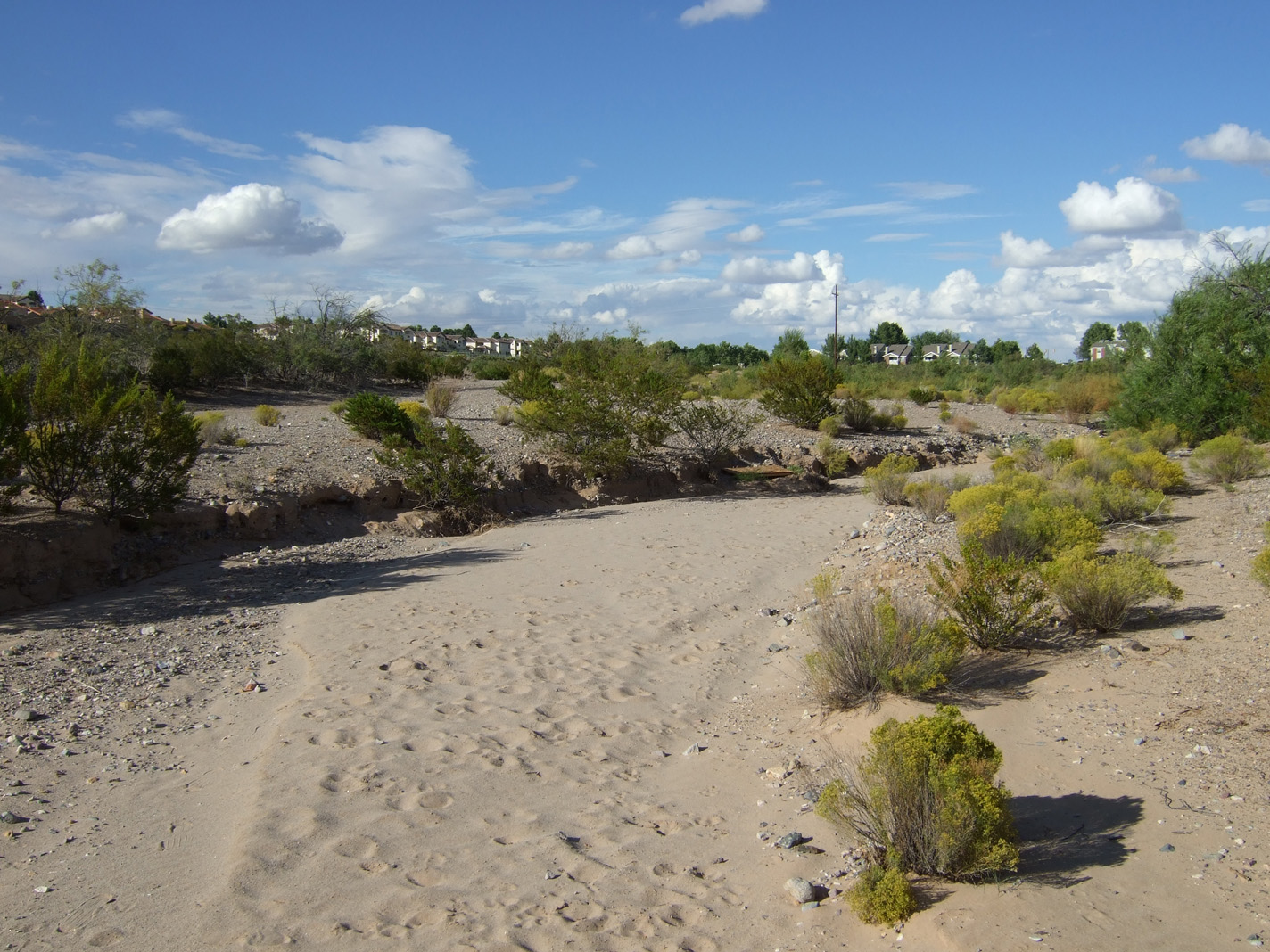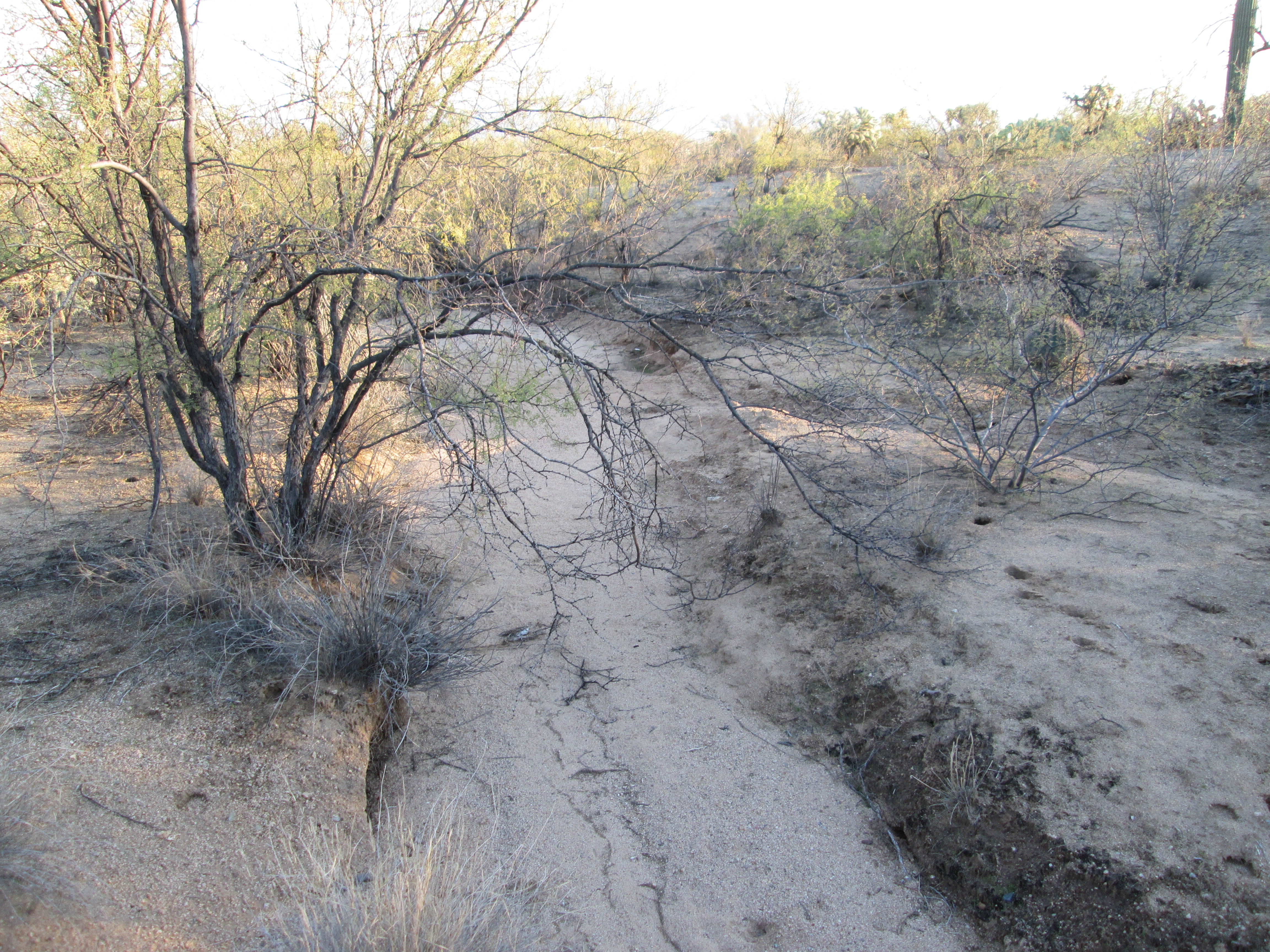Arroyo (creek) on:
[Wikipedia]
[Google]
[Amazon]



 An arroyo ( (from Spanish ''arroyo'' (, "brook"))) or wash is a dry
An arroyo ( (from Spanish ''arroyo'' (, "brook"))) or wash is a dry


 An arroyo ( (from Spanish ''arroyo'' (, "brook"))) or wash is a dry
An arroyo ( (from Spanish ''arroyo'' (, "brook"))) or wash is a dry watercourse
A stream is a continuous body of water, body of surface water Current (stream), flowing within the stream bed, bed and bank (geography), banks of a channel (geography), channel. Depending on its location or certain characteristics, a strea ...
that temporarily or seasonally fills and flows after sufficient rain
Rain is a form of precipitation where water drop (liquid), droplets that have condensation, condensed from Water vapor#In Earth's atmosphere, atmospheric water vapor fall under gravity. Rain is a major component of the water cycle and is res ...
. Flash floods are common in arroyos following thunderstorm
A thunderstorm, also known as an electrical storm or a lightning storm, is a storm characterized by the presence of lightning and its acoustics, acoustic effect on the Earth's atmosphere, known as thunder. Relatively weak thunderstorm ...
s. It is akin to the Catalan rambla, which stems from the Arabic
Arabic (, , or , ) is a Central Semitic languages, Central Semitic language of the Afroasiatic languages, Afroasiatic language family spoken primarily in the Arab world. The International Organization for Standardization (ISO) assigns lang ...
''rámla'', "dry river".
Similar landforms are referred to as '' wadi'' (in North Africa and Western Asia), ''chapp'' in the Gobi, ''laagate'' in the Kalahari, ''donga'' in South Africa, ''nullah'' in India, ''fiumare'' in Italy, and '' dry valley'' in England.
The desert dry wash biome
A biome () is a distinct geographical region with specific climate, vegetation, and animal life. It consists of a biological community that has formed in response to its physical environment and regional climate. In 1935, Tansley added the ...
is restricted to the arroyos of the southwestern United States. Arroyos provide a water source to desert animals.
Types and processes
Arroyos can be natural fluviallandform
A landform is a land feature on the solid surface of the Earth or other planetary body. They may be natural or may be anthropogenic (caused or influenced by human activity). Landforms together make up a given terrain, and their arrangement ...
s or constructed flood control channels. The term usually applies to a slope
In mathematics, the slope or gradient of a Line (mathematics), line is a number that describes the direction (geometry), direction of the line on a plane (geometry), plane. Often denoted by the letter ''m'', slope is calculated as the ratio of t ...
d or mountain
A mountain is an elevated portion of the Earth's crust, generally with steep sides that show significant exposed bedrock. Although definitions vary, a mountain may differ from a plateau in having a limited summit area, and is usually higher t ...
ous terrain in xeric and desert
A desert is a landscape where little precipitation occurs and, consequently, living conditions create unique biomes and ecosystems. The lack of vegetation exposes the unprotected surface of the ground to denudation. About one-third of the la ...
climates. In addition: in many rural communities arroyos are also the principal transportation routes; and in many urban communities arroyos are also parks and recreational locations, often with linear multi-use bicycle, pedestrian, and equestrian trails. Flash flooding can cause the deep arroyos or deposition of sediment on flooded lands. This can lower the groundwater
Groundwater is the water present beneath Earth's surface in rock and Pore space in soil, soil pore spaces and in the fractures of stratum, rock formations. About 30 percent of all readily available fresh water in the world is groundwater. A unit ...
level of the surrounding area, making it unsuitable for agriculture. However a shallow water table lowered in desert arroyo valley
A valley is an elongated low area often running between hills or mountains and typically containing a river or stream running from one end to the other. Most valleys are formed by erosion of the land surface by rivers or streams over ...
s can reduce saline seeping and alkali
In chemistry, an alkali (; from the Arabic word , ) is a basic salt of an alkali metal or an alkaline earth metal. An alkali can also be defined as a base that dissolves in water. A solution of a soluble base has a pH greater than 7.0. The a ...
deposits in the topsoil
Topsoil is the upper layer of soil. It has the highest concentration of organic matter and microorganisms and is where most of the Earth's biological soil activity occurs.
Description
Topsoil is composed of mineral particles and organic mat ...
, making it suitable for irrigated farming
Agriculture encompasses crop and livestock production, aquaculture, and forestry for food and non-food products. Agriculture was a key factor in the rise of sedentary human civilization, whereby farming of domesticated species created ...
.
Natural
The Doña Ana County Flood Commission in the U.S. state ofNew Mexico
New Mexico is a state in the Southwestern United States, Southwestern region of the United States. It is one of the Mountain States of the southern Rocky Mountains, sharing the Four Corners region with Utah, Colorado, and Arizona. It also ...
defines an arroyo as "a watercourse
A stream is a continuous body of water, body of surface water Current (stream), flowing within the stream bed, bed and bank (geography), banks of a channel (geography), channel. Depending on its location or certain characteristics, a strea ...
that conducts an intermittent or ephemeral flow, providing primary drainage for an area of land of or larger; or a watercourse which would be expected to flow in excess of one hundred cubic feet per second as the result of a 100 year storm
A storm is any disturbed state of the natural environment or the atmosphere of an astronomical body. It may be marked by significant disruptions to normal conditions such as strong wind, tornadoes, hail, thunder and lightning (a thunderstor ...
event." Research has been conducted in the hydrological modeling relative to arroyos.
Natural arroyos are made through the process known as arroyo-cutting. This occurs in arid regions, such as New Mexico, where heavy rains can lead to enlargement of rivers cutting into surrounding rock creating ravines which are dry under normal weather conditions.
It is argued, however, whether these excessively stormy periods are the sole cause of arroyo-cutting as other factors such as long-term climate changes must also be taken into account.Rice, R. J.; ''Fundamentals of Geomorphology,'' Longman, 1988 Further, overgrazing by livestock throughout the 20th century and today has removed vast amounts of surface vegetation which decreases ground infiltration of precipitation and increased runoff, increasing speed and energy of high flow rain events. Coupled with groundwater pumping this increases downcutting in arroyos as well. Arroyo cutting which occurred in the 1900s in the southwestern United States caused serious farming issues such as a lowered water table and the destruction of agriculture lands.
Constructed
Inagricultural
Agriculture encompasses crop and livestock production, aquaculture, and forestry for food and non-food products. Agriculture was a key factor in the rise of sedentary human civilization, whereby farming of domesticated species created f ...
areas in climates needing irrigation, farmer
A farmer is a person engaged in agriculture, raising living organisms for food or raw materials. The term usually applies to people who do some combination of raising field crops, orchards, vineyards, poultry, or other livestock. A farmer ...
s traditionally relied on small constructed arroyos, ''acequias'', ''zanjas'' or aqueduct channels and ditches for the distribution of water.
An example of larger constructed arroyos is in Albuquerque, New Mexico
Albuquerque ( ; ), also known as ABQ, Burque, the Duke City, and in the past 'the Q', is the List of municipalities in New Mexico, most populous city in the U.S. state of New Mexico, and the county seat of Bernalillo County, New Mexico, Bernal ...
. There are several miles of open-air concrete
Concrete is a composite material composed of aggregate bound together with a fluid cement that cures to a solid over time. It is the second-most-used substance (after water), the most–widely used building material, and the most-manufactur ...
lined drainage channels that drain an area into the main North Diversion Channel, a tributary
A tributary, or an ''affluent'', is a stream or river that flows into a larger stream (''main stem'' or ''"parent"''), river, or a lake. A tributary does not flow directly into a sea or ocean. Tributaries, and the main stem river into which they ...
of the Rio Grande
The Rio Grande ( or ) in the United States or the Río Bravo (del Norte) in Mexico (), also known as Tó Ba'áadi in Navajo language, Navajo, is one of the principal rivers (along with the Colorado River) in the Southwestern United States a ...
joining upstream of Albuquerque. After the San Juan Project Water Treatment Plant here, the Rio Grande's flow exceeding that needed for the river's silvery minnow habitat
In ecology, habitat refers to the array of resources, biotic factors that are present in an area, such as to support the survival and reproduction of a particular species. A species' habitat can be seen as the physical manifestation of its ...
is available for municipal water supply diversion. Signs are posted at the constructed arroyos warning to keep out due to danger of flash flooding.
The Arroyo Seco and Los Angeles River
The Los Angeles River (), historically known as by the Tongva and the by the Spanish, is a major river in Los Angeles County, California. Its headwaters are in the Simi Hills and Santa Susana Mountains, and it flows nearly from Canoga Park ...
are more famous examples in Southern California
Southern California (commonly shortened to SoCal) is a geographic and Cultural area, cultural List of regions of California, region that generally comprises the southern portion of the U.S. state of California. Its densely populated coastal reg ...
of former natural arroyo seasonal watercourses that became constructed open drainage system arroyos.
See also
* Billabong *Ravine
A ravine is a landform that is narrower than a canyon and is often the product of streambank erosion. Ravines are typically classified as larger in scale than gullies, although smaller than valleys. Ravines may also be called a cleuch, dell, ...
* Draw
* Wadi
References
External links
{{Authority control Fluvial landforms Erosion landforms Dry or seasonal streams Canyons and gorges Valleys